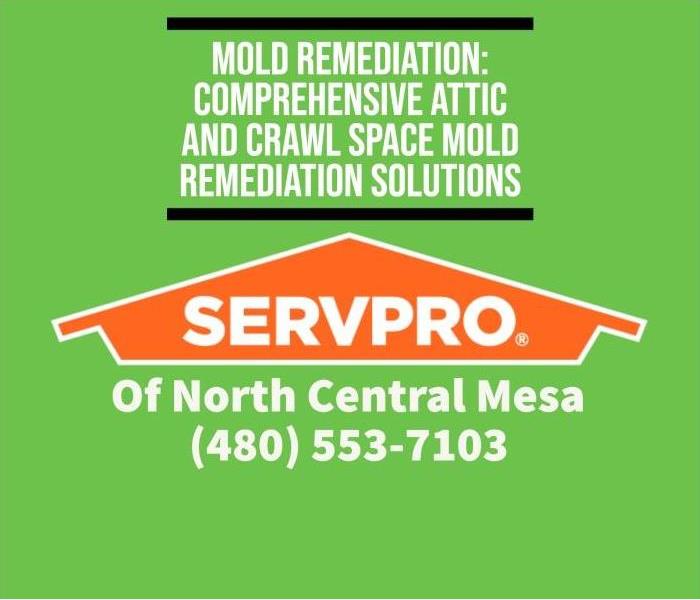Mold Remediation: Comprehensive Attic and Crawl Space Mold Remediation Solutions
4/5/2023 (Permalink)
Mold growth in attics and crawl spaces can pose significant health risks and property damage if not promptly addressed. SERVPRO of North Central Mesa offers expert attic and crawl space mold remediation services to ensure a safe and healthy environment for property owners and their occupants. In this blog post, we will discuss the causes of mold growth in attics and crawl spaces, how mold is removed from these areas, and the risks associated with mold exposure. Additionally, we will provide a FAQ section to answer further questions related to attic and crawl space mold remediation.
What Causes Mold in Attics and Crawl Spaces?
Mold growth in attics and crawl spaces is primarily caused by excess moisture and inadequate ventilation. Common causes of moisture in these areas include:
Roof leaks
Damaged or missing shingles, improper flashing installation, and ice dams can lead to water intrusion in the attic, creating a breeding ground for mold.
Plumbing leaks:
Leaking pipes in the walls or ceiling can cause moisture buildup in the attic or crawl space, promoting mold growth.
Condensation
High humidity levels and poor ventilation can lead to condensation, particularly on cool surfaces in the attic or crawl space, providing an ideal environment for mold.
Inadequate vapor barriers
Improperly installed or missing vapor barriers in crawl spaces can allow ground moisture to enter and encourage mold growth.
How is Mold Removed from Attics and Crawl Spaces?
Mold remediation in attics and crawl spaces involves several key steps to ensure thorough and effective removal of mold and prevention of future growth.
Assessment
A thorough inspection is conducted to identify the extent of the mold contamination, the types of mold present, and the source of the moisture problem. This information helps to develop a comprehensive remediation plan tailored to the specific needs of the property.
Containment
Containment is essential to prevent the spread of mold spores during the remediation process. Affected areas are sealed off using plastic sheeting and negative air pressure to ensure mold spores do not contaminate other parts of the property.
Mold Removal
Mold removal involves the physical removal of mold-contaminated materials. This may include the use of specialized equipment, such as HEPA vacuums and air scrubbers, to remove mold spores from surfaces and the air. In some cases, porous materials, like insulation, may need to be discarded and replaced due to extensive contamination.
Cleaning and Disinfection
After mold removal, all surfaces and belongings in the affected area are thoroughly cleaned and disinfected to eliminate any remaining mold spores and prevent future growth. This process may involve the use of specialized cleaning agents and HEPA-filtered vacuums.
Drying and Dehumidification (H3): To prevent future mold growth, it is crucial to address the underlying moisture problem. This may involve repairing leaks, drying wet materials, and using dehumidifiers to maintain appropriate humidity levels within the property.
Restoration
Once the mold remediation process is complete, the property is restored to its pre-mold condition. This may include replacing damaged materials, repainting walls, or reinstalling insulation.
What are the Risks of Mold Exposure?
Mold exposure can cause various health problems, particularly for individuals with pre-existing respiratory conditions or compromised immune systems. Common health risks associated with mold exposure include:
Allergic reactions
Mold exposure can trigger allergic symptoms such as sneezing, runny nose, itchy eyes, and skin irritation.
- Respiratory issues: Mold spores can cause respiratory problems, including coughing, wheezing, and difficulty breathing, especially in individuals with asthma or other respiratory conditions.
- Infections: In rare cases, mold exposure can lead to fungal infections, particularly in individuals with weakened immune systems.
- Long-term health effects: Prolonged mold exposure may increase the risk of developing chronic respiratory conditions or exacerbate pre-existing health issues.
Attic and Crawl Space Mold Remediation Solutions FAQs:
Q: How can I prevent mold growth in my attic and crawl space?
A: Preventing mold growth in attics and crawl spaces involves controlling moisture levels and ensuring proper ventilation. Regularly inspect your property for leaks, promptly repair any water damage, install vapor barriers in crawl spaces, and ensure your attic has adequate ventilation.
Q: How do I know if I have mold in my attic or crawl space?
A: Signs of mold in attics and crawl spaces include visible mold growth, a musty odor, unexplained allergic symptoms or respiratory issues, and a history of water damage or moisture problems in your property.
Q: How much does attic and crawl space mold remediation cost?
A: The cost of attic and crawl space mold remediation varies depending on the severity of the mold issue and the size of the affected area. Contact SERVPRO of North Central Mesa for a detailed estimate based on your specific needs.
Q: Can I remove mold from my attic or crawl space myself?
A: DIY mold removal is not recommended, as it can be dangerous and may not effectively address the issue. Certified professionals have the necessary knowledge, experience, and equipment to safely and effectively remove mold and prevent future growth.
Q: How long does attic and crawl space mold remediation take?
A: The duration of attic and crawl space mold remediation depends on the extent of the mold contamination and the size of the affected area. Smaller projects may take just a few days, while larger or more complex remediation can take several weeks.
Attic and crawl space mold remediation is essential for ensuring the safety and well-being of property owners and occupants. SERVPRO of North Central Mesa offers comprehensive mold remediation services, effectively addressing your mold concerns and restoring a healthy environment. If you suspect mold issues in your attic or crawl space, contact our team of certified professionals to schedule an assessment and discuss your specific needs.






 24/7 Emergency Service
24/7 Emergency Service
